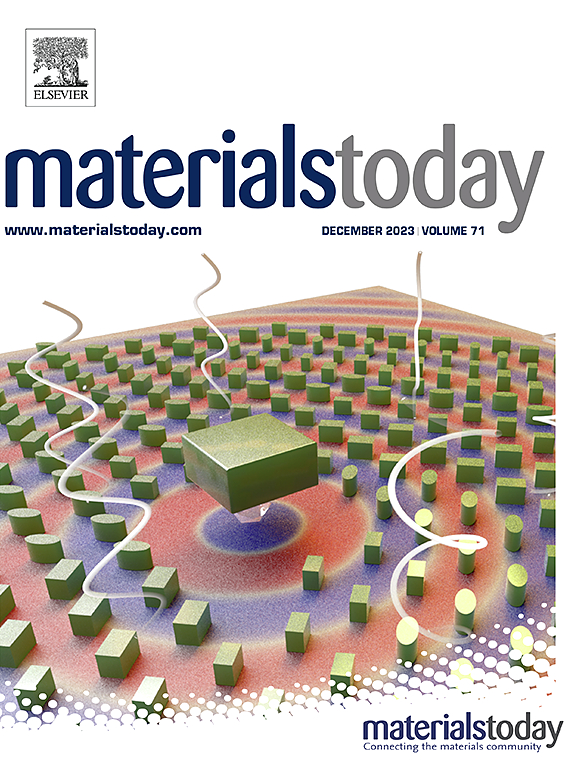通过双网络动态水凝胶实现3D打印性和血管形态发生
IF 21.1
1区 材料科学
Q1 MATERIALS SCIENCE, MULTIDISCIPLINARY
引用次数: 0
摘要
水凝胶是组织工程和生物制造应用的重要候选生物材料。水凝胶的基质动力学最近被证明有助于血管形态发生,这对组织血管化具有重要意义。然而,由于键解离和细胞介导的降解,这种动态水凝胶在培养过程中通常在机械上不稳定,这阻碍了它们在先进生物制造技术(如3D生物打印)中的应用。在这里,我们介绍了一种双网络动态水凝胶(DNDH)生物链接策略,以整合结构可打印性,稳定性和诱导血管形态发生。具体来说,我们合成了一种基于明胶的生物链,它由一个腙交联的动态水凝胶网络和一个甲基丙烯酸酯交联的非动态水凝胶网络组成。我们证明,我们优化的DNDH配方可以3D打印成定制结构,同时保持结构稳定性数周。此外,DNDH表现出基质动力学,其应力松弛时间比非动态对应物短得多,这被证明通过细胞-基质相互作用以刚度无关的方式触发血管形态发生。在基质中加入生化线索并与支持细胞共培养,进一步增强了血管网络的形成,并证实了DNDH相对于非动态对照物的优势。体内研究进一步证实了基质动力学在促进血管化中的重要性。我们的工作提供了一种可推广且易于使用的方法来将矩阵动力学引入生物墨水,这可以扩展动态水凝胶在生物制造场景中的能力。本文章由计算机程序翻译,如有差异,请以英文原文为准。

Enabling 3D printability and vascular morphogenesis with double network dynamic hydrogels
Hydrogels are crucial biomaterial candidates for tissue engineering and biofabrication applications. The matrix dynamics of hydrogels have recently been demonstrated to contribute to vascular morphogenesis, which is significant for tissue vascularization. However, such dynamic hydrogels are usually mechanically non-stable during culture due to bonding dissociation and cell-mediated degradation, which hinder their usage in advanced biofabricaiton technologies, such as 3D bioprinting. Here, we introduce a double-network dynamic hydrogel (DNDH) bioink strategy to integrate the structural printability, stability, and induction of vascular morphogenesis. Specifically, we synthesize a gelatin-based bioink that is composed of a hydrazone crosslinked dynamic hydrogel network and a methacrylate crosslinked non-dynamic hydrogel network. We demonstrate that our optimized DNDH formulation can be 3D printed into customized structures while retaining structural stability for weeks. Moreover, the DNDH exhibits matrix dynamics with a much shorter stress relaxation time than the non-dynamic counterpart, which is demonstrated to trigger vascular morphogenesis through cell-matrix interactions in a stiffness-independent way. The inclusion of biochemical cues in the matrix and co-culture with supporting cells further enhances the formation of vascular networks and confirms the advantages of DNDH over its non-dynamic counterpart. The in vivo studies further confirm the importance of matrix dynamics in vascularization promotion. Our work provides a generalizable and easy-to-use approach to introduce matrix dynamics to bioinks, which could expand the capability of dynamic hydrogels in biofabrication scenarios.
求助全文
通过发布文献求助,成功后即可免费获取论文全文。
去求助
来源期刊

Materials Today
工程技术-材料科学:综合
CiteScore
36.30
自引率
1.20%
发文量
237
审稿时长
23 days
期刊介绍:
Materials Today is the leading journal in the Materials Today family, focusing on the latest and most impactful work in the materials science community. With a reputation for excellence in news and reviews, the journal has now expanded its coverage to include original research and aims to be at the forefront of the field.
We welcome comprehensive articles, short communications, and review articles from established leaders in the rapidly evolving fields of materials science and related disciplines. We strive to provide authors with rigorous peer review, fast publication, and maximum exposure for their work. While we only accept the most significant manuscripts, our speedy evaluation process ensures that there are no unnecessary publication delays.
 求助内容:
求助内容: 应助结果提醒方式:
应助结果提醒方式:


